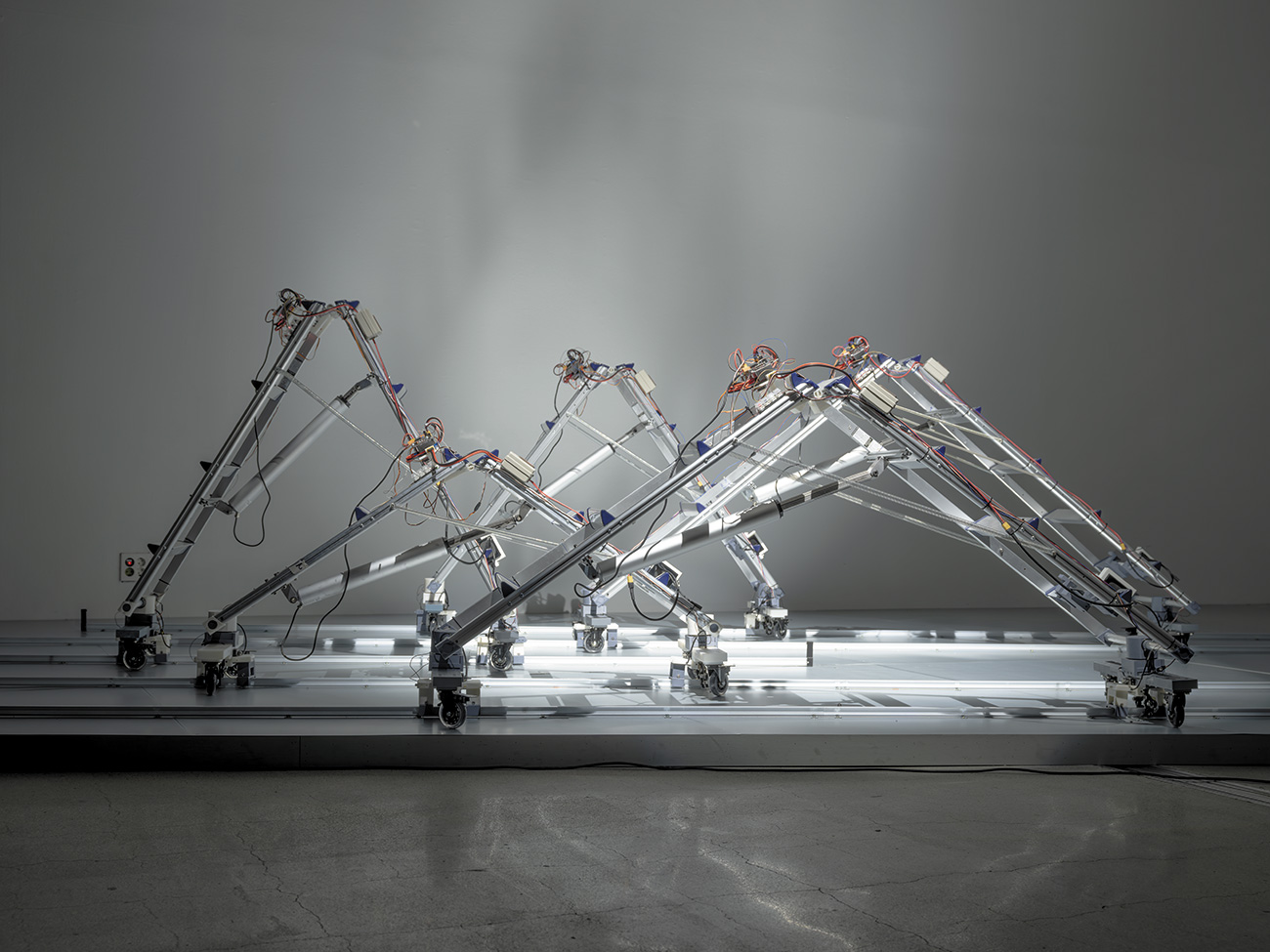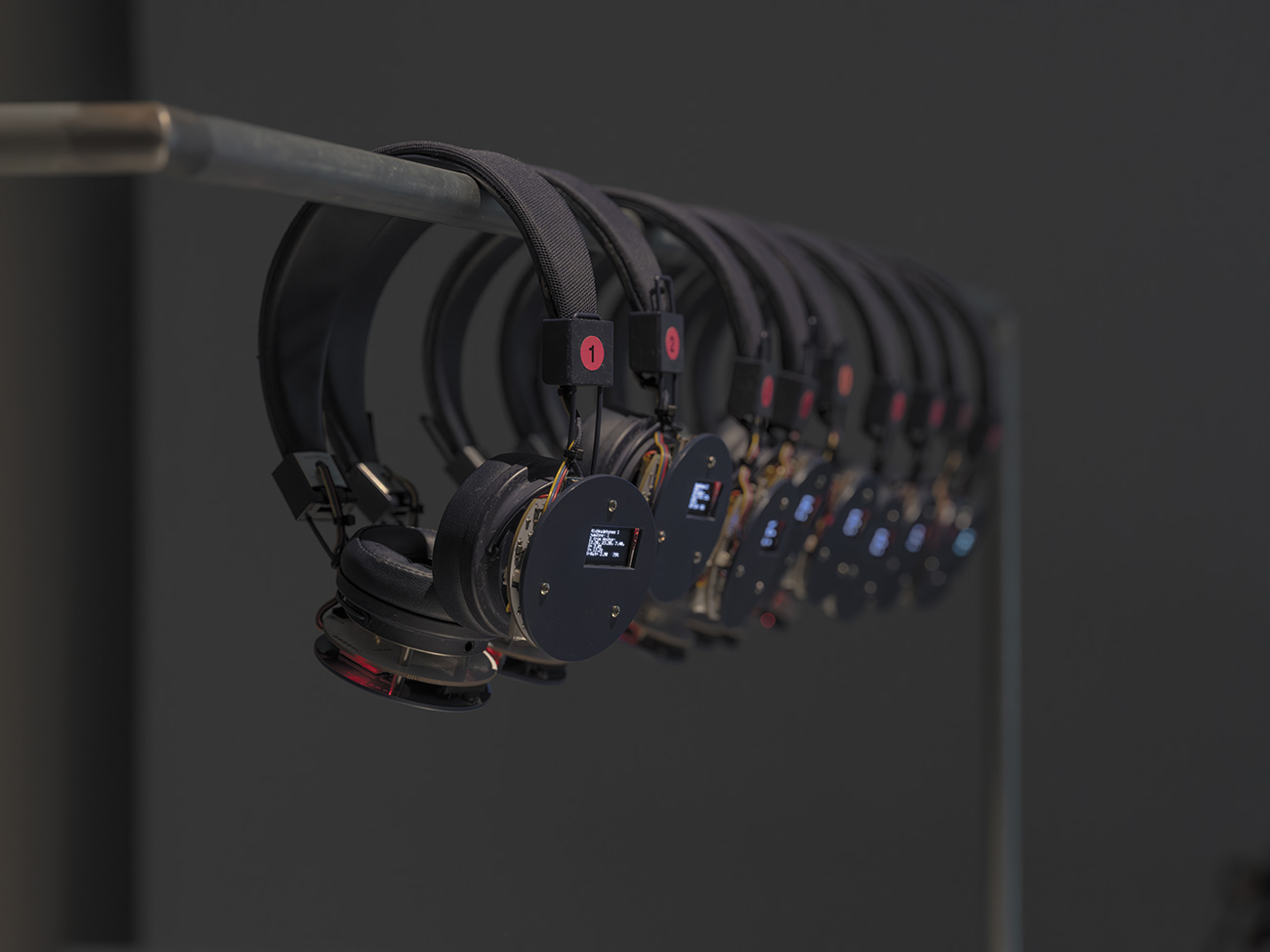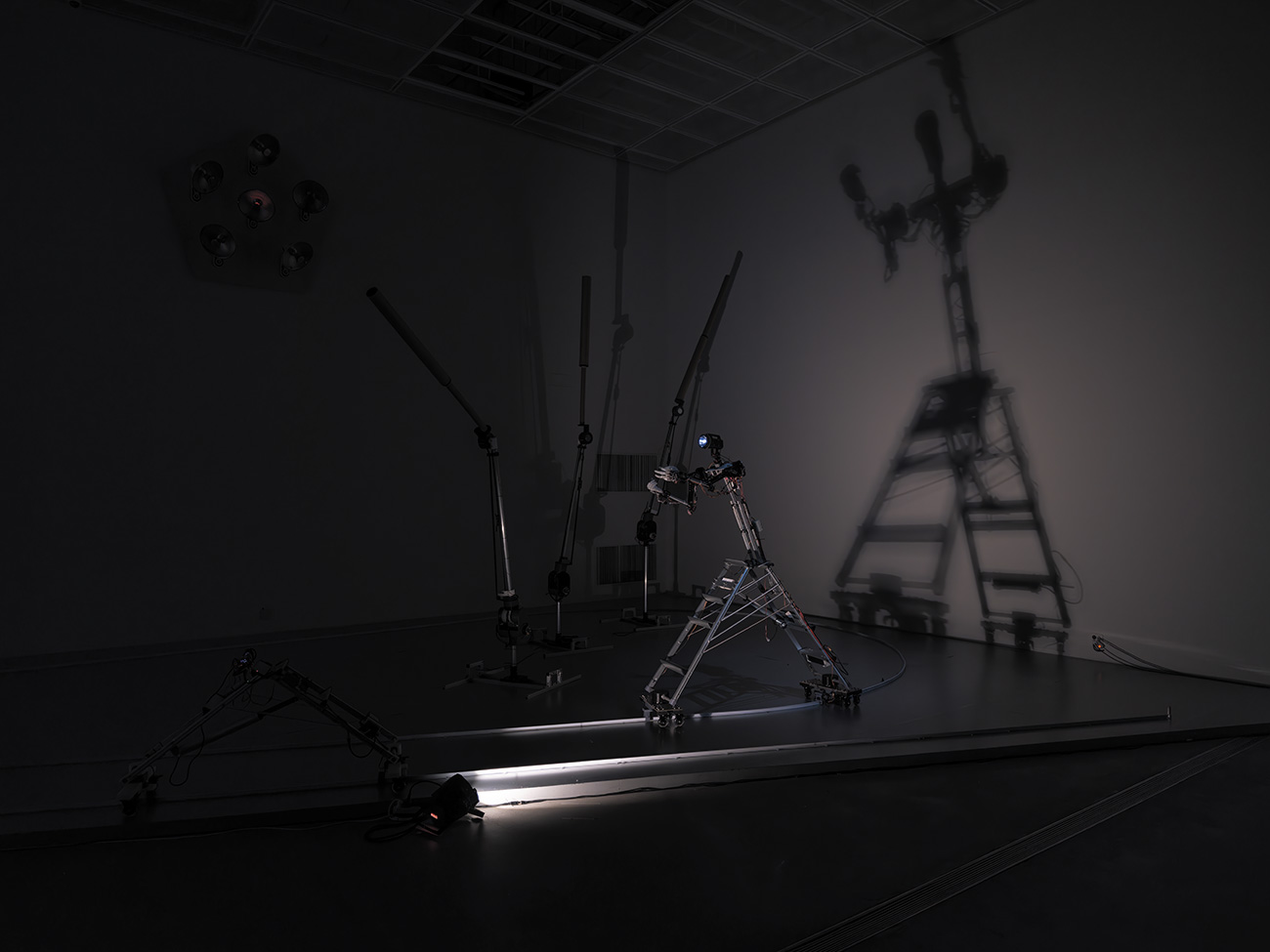LocationMMCA Seoul
DateOctober 2023 – March 31, 2024
Co-organizedMMCA Seoul, SBS Foundation
Unwavering and Decisive
His works are romantic. It may be because he is the most romantic person in the world. I have witnessed the irreplaceable traces he has inscribed upon the world of art, music, popular culture, and the underground scene over a long period of time, all without losing the heart of an artist. The artist’s heart that I have seen through him is one that is unwavering and decisive unshaken by cynicism, and above all a spirit of perseverance, which does not stop looking at the world as if encountering it for the first time, even in the face of inevitable failure. His works are, in this way, romantic and humane. The awkward words used to describe him will always remain of secondary importance. I feel guilty compressing the earnestness, subtlety, and well-subdued sadness of his work into the word “romantic,” which is too narrow a term, and yet I have difficulty explaining it in words other than romantic. The rhetoric of “romanticism” does not only convey gently heightened emotions. His works also have a cool and rough side. His exhibitions do not hide safely behind typical conventions and they say what they want to say without beating around the bush. The objects and scenes he performs combine somewhat precarious gestures and actions and reveal their vulnerability without adding or subtracting anything, rather than creating a beautiful sense of déjà vu all at once. These sentiments of precariousness and vulnerability lie at the root of his calling his robots “cheap cyborgs.” These aspects are not what we usually expect from technology or machines. He is an engineer who probes how technology for which its perfect end point has vanished operates as a homogeneous force, disappointing both futurists and reactionaries alike.
견고하고 단정한
그의 작품은 낭만적이다. 그가 세상에 둘도 없이 낭만적인 사람이기 때문일 것이다. 나는 그가 오랜 시간 작가의 마음을 잃지 않고 미술, 음악, 대중문화와 언더그라운드를 망라한 신에 새긴 대체 불가능한 흔적을 목격해 왔다. 내가 그를 통해 본 작가의 마음이란 냉소로 흐트러지지 않는 견고함과 단정함, 무엇보다 필연적인 실패를 직감하면서도 이제 막 세계를 알기 시작한 것처럼 세계를 바라보기를 멈추지 않는 인내의 마음가짐이다. 이런 그의 작업은 낭만적이고 다정하다. 그를 설명하기 위한 서투른 말은 어디까지나 부차적일 것이다. 나는 그의 작업이 지닌 진지함, 미세함, 잘 억제된 슬픔을 낭만이라는 좁은 단어에 눌러 담는 일에 죄책감을 느끼며, 그럼에도 낭만이 아닌 말로 그것을 달리 설명하는 데 어려움을 겪고 있다. 무엇을 ‘낭만적’이라 부르는 수사는 부드럽게 고양된 감정의 표현만을 뜻하지 않는다. 그의 작품엔 오히려 서늘하고 거친 면이 있다. 그의 전시는 전형적인 형식 뒤에 안전하게 숨어 하고 싶은 말을 에두르지 않는다. 그가 공연하는 사물과 장면은 단번에 아름다운 기시감을 자아내기보다 어딘가 위태로운 몸짓과 작용을 결집하고 그들의 취약함을 가감 없이 드러낸다. 이 위태로움과 취약함이야말로 그가 자신의 로봇을 ‘싸구려 인조인간’이라 부른 근원의 정서다. 이러한 면모는 우리가 흔히 기술이나 기계에 기대하는 바가 아니다. 그는 망설임 없이 미래주의자와 복고주의자 모두를 실망시키면서, 무결한 도달점이 사라진 기술이 균질한 힘으로 작용하는 방식을 살피는 엔지니어다.

At some point, he wrote the following about robots. Robots are comrades who had each other’s backs in the club scene in the 1990s. Robots are strangers, foreign workers, who urged him to take interest in “non-beings.” Robots are refugees who have lost their coordinates. Robots are drunks. Robots that are assembled from miscellaneous hardware and have lost their purpose appear to have each their own defects. Our comrades went their separate ways and art that did not cater to capital was forgotten. Strangers are repeatedly deported. Hometown has become an obsolete word for everyone. Drunks wander in their dreams and suffer from hangover. For some reason, robots appear to wander like ghosts unable to take one side or another. His robots operate based on the same ethics as humans. And the moment they come into conflict with a universally legitimate promised order (“truth” for Kwon Byungjun) or episteme (philosophical high culture for Yuk Hui), they embrace and awaken each other’s malfunction.
그는 언젠가 로봇에 대해 쓴다. 로봇은 1990년대 클럽 신에서 서로의 곁을 지킨 동료다. 로봇은 그에게 ‘없는 존재’에 대한 관심을 촉구한 이방인, 이방의 노동자다. 로봇은 좌표를 잃은 난민이다. 로봇은 주정뱅이다. 자질구레한 철물을 조립해 결과적으로 용도 불명에 이른 로봇은 저마다의 결함을 가진 것처럼 보인다. 동료들은 흩어졌고 자본에 영합하지 않은 예술은 잊혔다. 이방인들은 거듭 추방당한다. 고향은 누구에게든 사어가 되었다. 취객은 꿈속에서 헤매며 숙취로 고통 받는다. 로봇은 왜인지 어느 편에도 선뜻 마음을 주지 못한 채 유령처럼 배회하는 그 자신 같다. 그의 로봇은 인간과 동종의 윤리에 기반해 작동한다. 그리고 그것이 보편타당하게 약속된 질서(권병준에게는 ‘진리’) 혹은 에피스테메(육후이에게는 철학적 상위문화로서의)와 대립하는 순간 서로의 오작동을 끌어안아 각성한다.

Kwon Byungjun’s most striking theatrical element is the use of shadows. Most of his robot series create shadows with artificial light. Here, curators and critics already find themselves at a loss. In so far as the shadow is subordinated to the object and seen as a passive support, it brings up the memory of classical philosophy devaluing classical art as an inferior representation. This is because it is a form of visuality that modern art avoids in that the support is an obscure illusion and gives rise to a groundless “feeling.” Moreover, the robot, chosen as the main character in the spotlight, is mistaken for the personification of an object, causing trouble once again—within the upheaval of new materialism, the personification of an object will be read as a worn out symbol of the art of the past. However, the shadow is not simply a theatrical element that stirs up a “feeling.” For example, if we pay attention to the fact that the robot in Club Golden Flower is a luminous body with a lantern grafted onto its face, the robot’s shadow makes visible the connectivity that organizes “the construct that includes itself, including itself.” Also, artificially enhanced lighting is an autobiographical symbol of power, self-consciousness, and pain in that it is the performance industry’s way of objectifying something. Therefore, the artificial light in his play is the robot’s prosthetic body, extended like another substance, composing a cluster of mechanical devices. The robot in the Korea Artist Prize 2023 repeats the political gesture that overheats the the human world’s networks, such as the ritual prostration, sambo ilbae (three steps, one bow). At the same time, however, the robot is broken down by light and the white cube into the movement of things or machines. What is maximized here is not the double representation or illusion of space through the mobilization of shadows, but the strange experience of materialization in which bodies and prosthetic bodies are mixed and scattered in uniform waves on the wall.
A Cold and Unwavering Romanticism - On Kwon Byungjun’s Mechanical Theater
Written by Yoon Juli
Chief Curator, Ilmin Museum of Art
권병준의 극적 요소로 가장 두드러지는 것이 그림자의 활용이다. 로봇에 관한 그의 연작은 대부분 인공적인 빛으로 그림자를 생성한다. 여기서 큐레이터와 비평가들은 이미 난감한 입장에 처하는데, 그림자는 대상에 종속되어 수동적으로 열화한 것이란 점에서 고전 철학이 고전 미술을 열등한 재현으로 평가 절하한 기억을 상기시키며, 지지체가 불분명한 환영으로서 근본 없는 ‘기분’을 야기한다는 점에서 현대 미술이 기피하는 시각성이기 때문이다. 게다가 스포트라이트를 받는 주인공으로 선택된 로봇은 사물의 의인화로 오인되며 재차 곤란함을 유발한다―신유물론의 광풍 속에서 사물의 의인화는 지난 미술의 낡은 기호로 읽힐 것이다―. 하지만 그림자가 단순히 ‘기분’을 불러일으키는 극의 요소인 건 아니다. 예를 들어 《클럽 골든 플라워》의 로봇이 랜턴을 얼굴 부위에 이식한 발광체라는 사실에 주목하면, 로봇의 그림자는 ‘자신을 포함해 자신을 포함한 구성체’를 조직하고 있는 연결 상태를 가시화한다. 또 인공적으로 강화된 조명이야말로 공연 산업이 무언가를 대상화하는 방식이란 점에서 그것은 힘과 자의식, 고통에 관한 자전적인 표상이다. 그러므로 그의 극에서 인공적인 빛은 기계 장치의 군집을 구성하는, 또 다른 물질처럼 연장된 로봇의 의체다. 《올해의 작가상 2023》에서 로봇은 오체투지, 삼보일배와 같이 인간 세계의 연결망을 과열시키는 정치적 몸짓을 반복하고 있다. 그러나 동시에 로봇은 빛과 화이트큐브에 의해 사물 혹은 기계의 움직임으로 부서진다. 여기서 극대화되는 것은 그림자를 동원한 이중 재현이나 환영의 공간감이 아니라 신체와 의체가 뒤섞여 벽면 위에 균등한 파장으로 흩어지는 기묘한 물화의 경험이다.
글: 윤율리, 일민미술관 책임큐레이터
© 2024 Byungjun Kwon All rights reserved.





